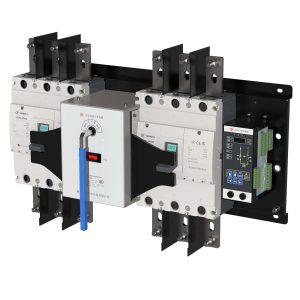In today’s electricity-dependent society, any power outage can result in significant losses. As an important device to ensure the continuity of critical power supply, the Automatic Transfer Switch (ATS) can quickly switch to the backup power supply when the main power fails, thereby ensuring the power needs of industry, commerce and residents. The operating concept, major components, types and application scenarios of ATS, comparison with uninterruptible power supply system (UPS), and installation and configuration aspects of ATS will be discussed in this paper.

Automatic Transfer Switch
Automatic transfer switch’s working concept
ATS operates on a real-time monitoring of power supply status basis. Its major purpose is to automatically turn to the backup power source in case the main one fails to provide flawless supply. Through the built-in current sensor, ATS tracks the power supply condition. Once the main power is disconnected or the voltage is abnormal, the controller will immediately issue a switching command. Following the command, the contactor rapidly turns off the main power connection and finishes the transition to the backup power supply in a somewhat short period. Usually finished in a few milliseconds, this process minimizes the influence on the load.
Main parts of automatic transfer switch devices
ATS consists mostly in contactors, controllers, sensors, and switching devices. Load currents are carried and switched by contactors; controllers, the brains of ATS, monitor power status and provide switching instructions; sensors detect real-time aberrant conditions of the power supply; and switching devices actually execute circuit switching actions. These parts cooperate to guarantee ATS’s consistent performance of automatic switching tasks.
Types and application scenarios of automatic transfer switch appliances
ATS can be separated into mechanical and static ATS depending on technical implementation and application criteria. Static ATS offers quick switching speed, using electronic control technology, and generates no arcs by mechanical contactors. It is appropriate for events like data centers and medical facilities where very high standards for power quality apply. Low in cost and fit for general industrial and commercial uses, mechanical ATS achieves switching via mechanical contactors. Different types of ATS are applied to various scenarios according to their characteristics to meet different power supply needs.
Comparison of uninterruptible power supply systems (UPS) and automatic transfer switch devices
Although they have different design and purpose, both ATS and UPS are significant backup power sources in power systems. ATS is mainly used to automatically switch between the main power supply and the backup power supply, and is suitable for scenarios with long-term backup power demand. Conversely, UPS is appropriate in cases when brief power disruptions avoid damage to equipment and offers a temporary power supply to let the system have enough time to switch or shut down.
Installation and configuring of automatic transfer switch appliances
Key processes to guarantee ATS’s normal operation are its installation and configuration. First, it is necessary to select the appropriate ATS model and specifications based on the load characteristics and power requirements. Second, the site of the installation should be handy for maintenance and not compromise any other power system element. When configuring, it is necessary to consider the compatibility of ATS with the existing power system and the integration with the backup generator or battery system. Furthermore required steps to guarantee the long-term reliable operation of ATS are regular maintenance and testing.
As a key guarantee for the continuity of power supply, the correct selection, installation and configuration of automatic transfer switch appliances are crucial to ensuring the reliability of the power system. With the development of technology and the growth of application demand, ATS will continue to play an important role in the field of power supply security. Deeply knowing the working principle, components, types, comparison with UPS, and installation and configuration points of ATS will help us to apply this technology more wisely to guarantee the stability and security of vital power supply.
Post time: 7 月-09-2024


